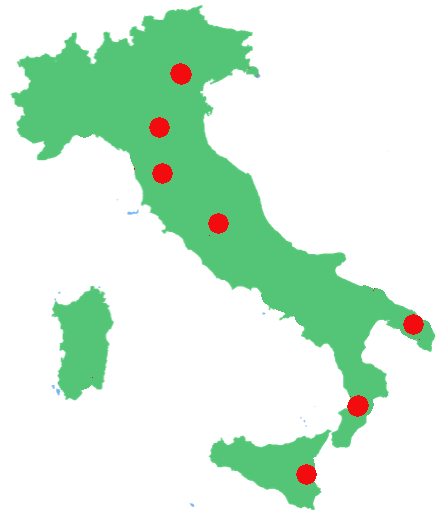Scientific activities of the various Research Units
Bologna
-
Application of Statistical Physics methods to socio-economical and biological systems.
The main goal is to understand how the macroscopic statistical laws that are suggested by
the empirical observations on complex systems can be justified according to the dynamical
properties of the heterogeneous elementary components and their interaction network.
We propose a mesoscopic approach to study the emergent properties by developing a statistical
physics approach to stochastic dynamical systems which interact through a network like structure.
We will take advantage from the results of stochastic dynamical systems theory and the network theory.
The goal is to characterize the existence of equilibria, stationary and almost stationary states,
critical states and phase transitions. We also plan to develop a thermodynamic approach to describe
the non-equilibrium states of the system and to study the fluctuation effects.
Catania
-
Beneficial role of random strategies in social and economics systems. Noise and ether-drift experiments.
SOC models in Complex Networks with different topologies. Altruism in collective games on different networks.
Agent based models simulations. Topological structure of multiplex networks. Phase transition in growing
systems. Remote synchronization and network symmetries. City ecosystem resilience analysis.
Evolutionary dynamics of social interactions
Cosenza
-
Mathematical models of semiconductors. Macroscopic models for transportation of charge carriers
from the semiclassical Boltzmann equation, coupled with the principle of maximum entropy.
Microscopic models for confined electrons in silicon devices, semiclassical in the direction
transverse (hydrodynamic system), including quantum effects in the direction of confinement
(Schroedinger-Poisson system). Theory of cellular neural networks for complexity, self-organizing
systems and artificial life.
Firenze
-
We extended the concept of Turing instability to a generalized setting that holds promise to bridge the gap between theory and observation. We study pattern formation (e.g. Turing patterns and travelling wave) for reaction diffusion systems defined on a complex network (random/scale free), considering both stochastic and deterministic frameworks. We also study the process of diffusion under severe crowding condition for systems defined on both a regular lattice and/or a network.
Neuronal networks with short and long term plasticity: analysis of the response to impulsive stimuli. We investigate the response of an excitatory plastic network (exhibiting bursting behaviour) with power-law distributed connectivity to impulsive stimuli.
Neuronal networks with short and long term plasticity: analysis of the response to impulsive stimuli.
We investigate the response of an excitatory plastic network (exhibiting bursting behaviour) with
power-law distributed connectivity to impulsive stimuli.
Dynamics of evolutive ecosystems: sympatric speciation, sexual selection, small-world effects
in evolution. Human evolution and emergence of human huristics. Emergence of cognitive structures
beyond the neural network concept (with experiments). Dynamics of small groups (with experiments).
Opinion formation and the role of non-conformism. Interplay between risk perception, human heuristics
and disease spreading. Applications of human heuristics to computer sciences.
Landslides triggering by rainfall and propagation by means of a model inspired by molecular dynamics.
Models of ants battle (with experiments).
Lecce
-
tudy of the desertification transition in semi-arid ecosystems. Abrupt desertification
transitions induced by several kinds of external stresses and identification of
early warning signals of desertification.
Padova
-
Diffusion and sensing of signal molecules in bacterial colonies. The theoretical modeling will be
developed in close connected with experiments run by Prof. A. Squartini at DAFNAE (Unipd).
Emergence of nested structures in ecosystems.
Anomalous dynamics of polymers, especially translocation. Active matter models.
The impact of fragmentation on biodiversity of the environment '(disordered ecosystems).
Models for earthquakes where each event can be seen as a unit that generates
off-springs according to its magnitude and to known correlations between events.
Methods of the physics of complex systems applied to quantitative finance.
Modeling of asset dynamics inspired by the renormalization group approach to
critical phenomena. Option pricing beyond Black-Scholes based on closed formulas.
Network of virtual water flows (any amount 'of food can' be
converted into a cost in terms of water needed to produce it).
Perugia
Diffusion and mobility of interacting particles moving in confined systems, by means of massively parallel simulations running on graphics cards. Evolution of self-propelling interacting particles. The investigated models are relevant in understanding the behaviour of bacteria colonies and will be studied using graphics card simulations.
Macroscopic description of a system by means of probabilities assigned to macro-variables in order to account for the lack of knowledge about their relations with the microscopic entities. The dynamics of such probabilities should take place according to information constraints. We propose the use of Riemannian geometry applied to probability theory together with inductive statistical inference (Maximum Relative Entropy methods). We investigate the interconnections curvature, topology and complexity of motion (geodesic spread).


